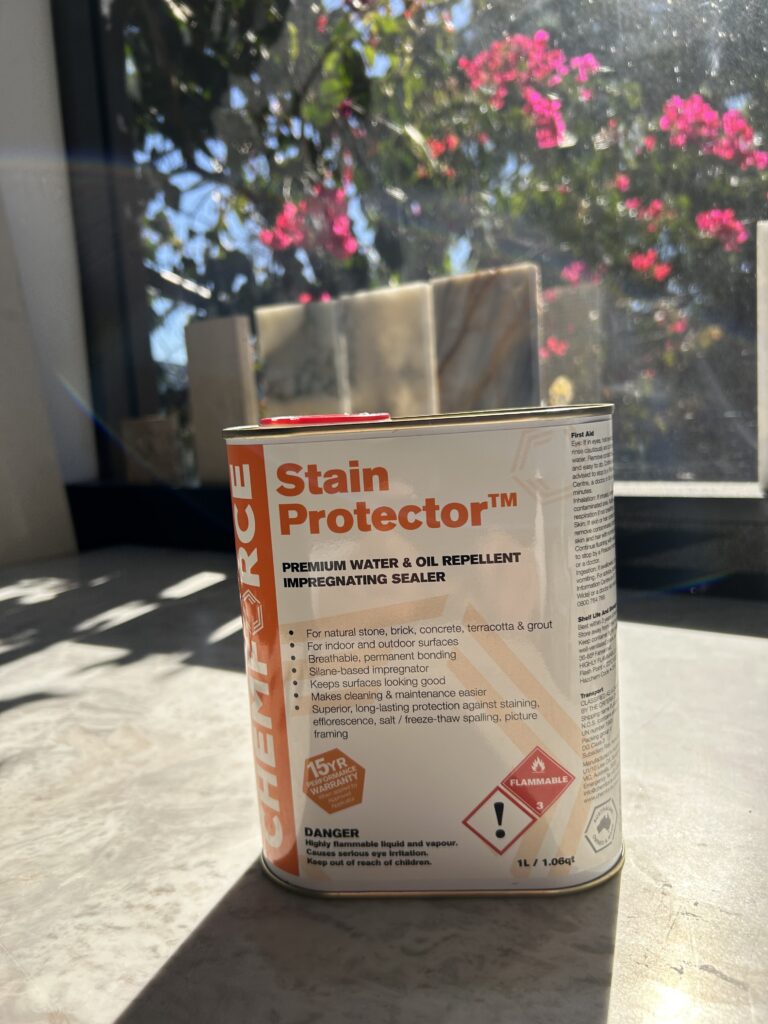Sealing is essential to protect and maintain the beauty and durability of your natural stone surfaces, whether indoors or in outdoor spaces.
Natural stone surfaces, such as granite, marble, slate, and limestone, are popular choices for countertops, floors, and other architectural features due to their durability and aesthetic appeal. However, to maintain their beauty and longevity, proper stone sealing is essential.
This complete guide will cover everything you need to know about stone sealing, from the importance of sealing to the step-by-step process and maintenance tips.
Why is stone sealing essential for natural stone surfaces?
Natural stone is porous and can absorb oil, dirt, and organic stains, leading to damage and discolouration.
Sealing creates a protective barrier that protects against stains and moisture, enhancing your stone’s appearance and extending its longevity. It also makes regular cleaning easier and helps maintain your stone’s aesthetic appeal.

What are the different types of stone sealers?
Choosing the right stone sealer depends on your stone type, location, and lifestyle. Below is a comparison of the two main types to help you make an informed decision:
Feature | Penetrating Sealers | Topical (Surface) Sealers |
How It Works | Soaks into stone pores | Forms a protective layer on top |
Appearance Change | Minimal—preserves natural look | Enhances colour and sheen |
Best For | Kitchens, bathrooms, pavers | Decorative walls, low-traffic areas |
Durability | High—lasts 3–5 years | Moderate—requires reapplication (1–2 years) |
Maintenance | Low—easy cleaning | Higher—can wear, peel, or haze |
Stain Resistance | High—blocks absorption | High—blocks surface contact |
Outdoor Use | Excellent (weather-resistant) | Limited (can degrade in sun/moisture) |
Recommended by STS | ✅ Ideal for daily use in homes | ✅ For aesthetic enhancement only |
There are two main methods for sealing natural stone:
- Penetrating sealers soak into the stone, filling pores to create a lasting protective barrier without altering the natural look. These are ideal for most natural stone surfaces, including granite, marble, limestone, sandstone, and pavers.
- Topical sealers form a protective layer on the surface, enhancing aesthetic appeal and durability. Both types help maintain and protect your stone surfaces.
Let’s unpack these two more.
For high-traffic, moisture-prone areas like kitchens, bathrooms, and outdoor pavers, penetrating sealers are almost always the best choice. They work from within the stone, protecting against stains and wear without altering the natural look, ideal for maintaining the authenticity of granite, marble, or limestone.
Because they last longer and require less maintenance, they’re a practical, durable solution for everyday living.
Topical sealers, while effective at enhancing colour and sheen, are better suited for walls or low-traffic decorative areas where appearance is the priority. They can be more sensitive to UV light, foot traffic, and cleaning products, which may lead to hazing or peeling over time, especially in Australia’s harsh climate.
At Stone & Tile Studio, we recommend them selectively and always advise a test patch first. For peace of mind and the best long-term results, our team in Zillmere can help you match the right sealer to your stone, lifestyle, and location.
How do I choose the right sealer for my stone surfaces?
Consider your stone type, its location (indoors or outdoors), and the level of exposure to elements. Penetrating sealers are recommended for floors, countertops, and pavers exposed to grime and traffic.
Topical sealers are suitable for walls or areas needing extra protection and a richer finish. Always test the sealer on a small, inconspicuous area before full application.
RECOMMENDED PRODUCT Stone & Tile Studio recommends Chemforce Stain Protector™ for most porous natural stone and outdoor pavers due to its superior water and oil repellence, UV and chemical resistance, and breathability (use Fortifier Plus™ for salt-water pool surrounds). Key Benefits:
Usage Note: Always test on a small, inconspicuous area first. Allow up to 3–4 weeks for full cure and optimal repellence. |
If you choose to contract a certified company to seal your stone with Chemforce, you are eligible for the Chemforce 15-year warranty, ensuring peace of mind and long-lasting protection (conditions apply).
How do I properly seal natural stone surfaces?
Clean the stone thoroughly with a mild detergent.
Stone & Tile Studio recommends Chemforce 5+5 pH Neutral Cleaner for tiles and natural stone; avoid harsh chemicals that damage the sealer and stone’s surface. Use a soft-bristle brush to remove dust, debris, and grime, then rinse and let the stone dry completely (several hours may be required).
Apply the sealer using a clean cloth or sponge, working in small sections. Follow the manufacturer’s instructions for drying time, number of coats, and curing. Wipe off any excess sealer to prevent a hazy finish. Allow the sealer to dry completely and cure as directed.
What maintenance is required after sealing natural stone surfaces?
Regular cleaning is vital for longevity. Use Chemforce 5+5 pH Neutral Cleaner for safe, effective cleaning; avoid harsh chemicals, acidic cleaners, or abrasive pads.
Clean spills promptly to protect against stains. Use mats and coasters in kitchens and bathrooms to shield surfaces from heat and spills. Inspect regularly for wear or damage—if water no longer beads on the surface, it may be time to reseal.
Resealing frequency depends on use and location but is typically every 1–3 years.
People also ask about stones and sealing concerns
To help you make informed decisions and keep your natural stone surfaces in top condition, here are answers to some frequently asked questions about stone sealing and maintenance.
1. Can I use any cleaner on natural stone surfaces?
No. Avoid harsh chemicals and acids. Use Chemforce 5+5 pH Neutral Cleaner for safe, effective cleaning of tile and stone. This protects the sealer and helps maintain your stone’s appearance.
2. How long does sealing take?
Drying time varies, but it typically takes several hours for the stone to dry completely. Complete curing may require 24–48 hours, depending on conditions and sealer type.
3. How often should I reseal stone surfaces?
Resealing depends on use and location. High-traffic floors may need resealing every 1–2 years, while walls or less-exposed areas can go longer—often 3–5 years. Regular inspection helps you decide when it’s time.
4. Can I seal outdoor natural stone pavers?
Yes. Penetrating sealers are ideal for outdoor natural stone pavers. Clean and dry the pavers thoroughly before application. This helps protect against moisture and stains in outdoor spaces.
5. What is the difference between penetrating and topical sealers?
Penetrating sealers protect from within by soaking into pores without changing the stone’s appearance. Topical sealers create a protective layer on the surface and can enhance colour and sheen, but may require more frequent maintenance.
How can I contact Stone & Tile Studio for expert advice?
For expert advice, recommended products, and professional cleaning services, visit Stone & Tile Studio’s Zillmere showroom in Brisbane.
Our team specialises in restoration, installation, and long-term maintenance, helping you protect your investment and preserve the unique beauty of natural stone.
Why choose natural stone?
Natural stone surfaces (granite, marble, limestone, sandstone, and more) are popular choices for floors, walls, and countertops across Australia.
Natural stone adds value to your property: while installation and material cost more, it offers unmatched durability, aesthetic appeal, and unique character. Every slab is unique, outlasting other surfaces with minimal upkeep.
Your stone is an investment. Protect its beauty and longevity with the right sealing and maintenance.
Contact us today to explore the best solutions for your natural stone surfaces in Brisbane and Southeast Queensland.

